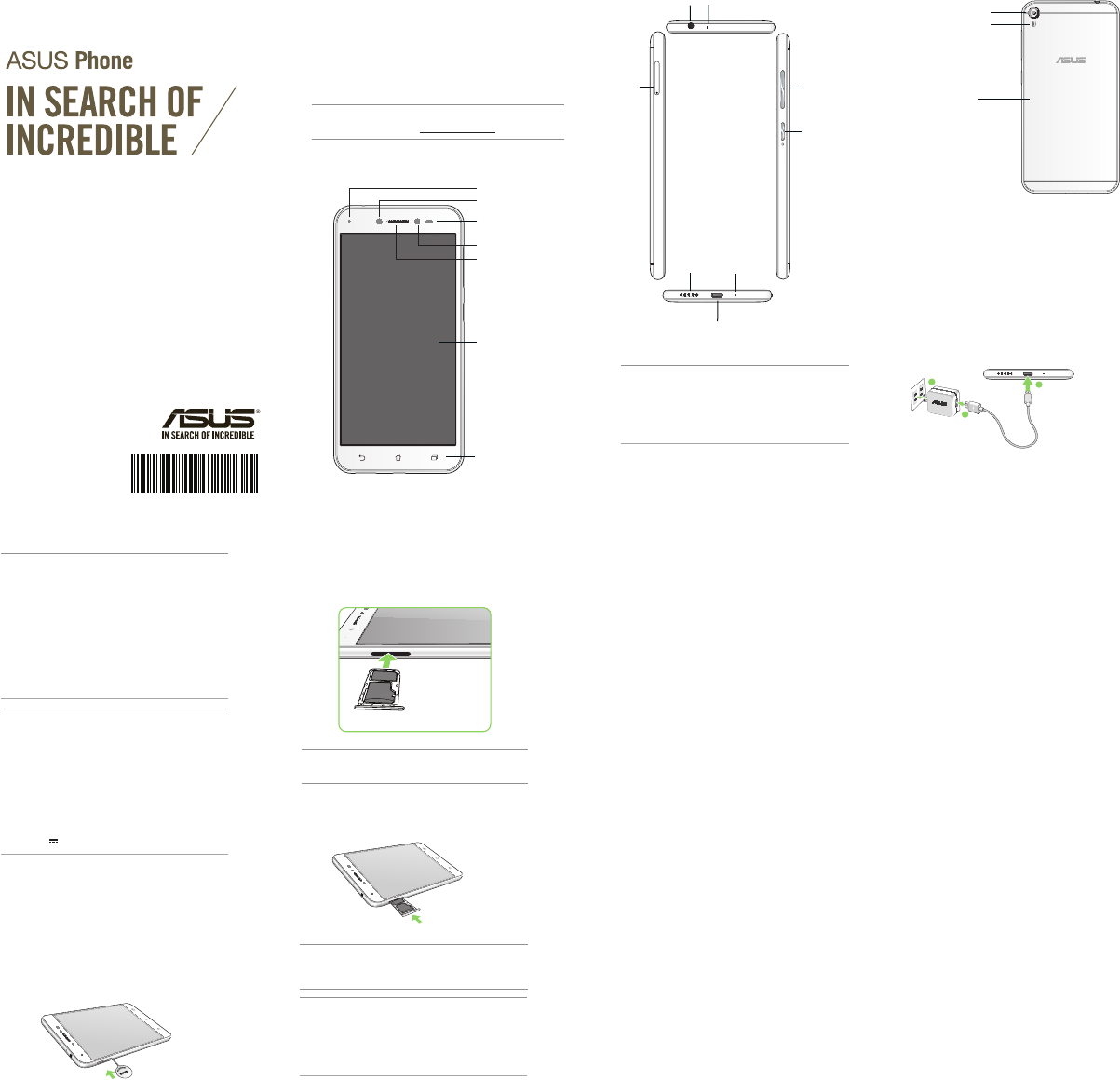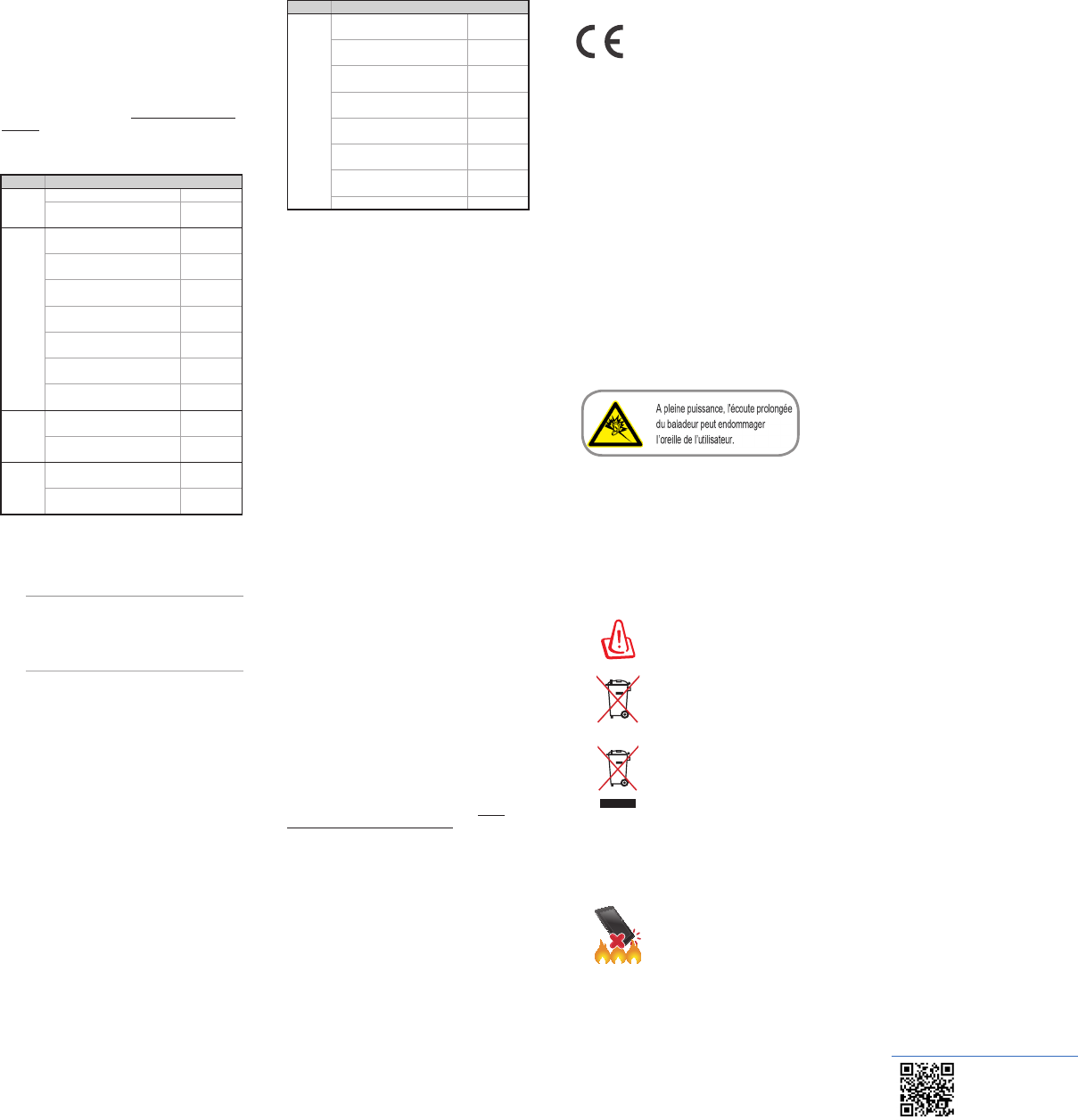ASUSTeK Computer A007 ASUS Phone User Manual
ASUSTeK Computer Inc ASUS Phone
Contents
- 1. User Manual
- 2. User manual
User manual

Revised Edition/ July 2017
Model: ASUS_A007 (ZB501KL)
Before you start, ensure that you have read all the safety
information and operating instructions in this User Guide
to prevent injury or damage to your device.
NOTE: For the latest updates and more detailed
information, please visit www.asus.com.
Front features
Side features Rear features
E13301
User Guide
Touch screen
display
Receiver
Touch keys
Front camera
LED indicator
Camera Flash
Proximity sensor
and light sensor
Power key
Audio jack
Micro USB port
Microphone
Volume key
Speaker Microphone
NOTES:
• TheNanoSIMcardslotssupportLTE,
WCDMA and GSM/EDGE network bands.
• ThemicroSDcardslotsupportsmicroSDand
microSDXC card formats.
Nano SIM1,
Nano SIM2
/ MicroSD
combo card
slot
Rear camera
Camera ash
Rear cover
Charging your ASUS Phone
To charge your ASUS Phone:
1. Connect the USB connector into the power
adapter’s USB port.
2. Connect the other end of the micro USB cable
to your ASUS Phone.
3. Plug the power adapter into a wall socket.
NOTES:
• Forsafetypurposes,useONLY the bundled
power adapter and cable to avoid damaging
your device and prevent the risk of injury.
• Forsafetypurposes,useONLY the bundled
power adapter and cable to charge your
ASUS Phone.
• Theinputvoltagerangebetweenthewall
outlet and this adapter is AC 100V - 240V.
TheoutputvoltageofthemicroUSBcableis
+5.2V 1A, 5.2W.
IMPORTANT!
• WhenusingyourASUSPhonewhileitis
plugged to a power outlet, the grounded
power outlet must be near to the unit and
easily accessible.
• WhenchargingyourASUSPhonethrough
your computer, ensure that you plug the USB
cable to your computer’s USB 2.0 port.
• AvoidchargingyourASUSPhoneinan
environment with ambient temperature of
above 35oC (95oF).
3
1
2
Installing a Nano SIM /MicroSD card
To install a Nano SIM / MicroSD card:
1. PushapinintotheholeontheNanoSIM/
MicroSD card tray to eject it.
2. InserttheNanoSIMorMicroSDcard(s)into
the card slot(s).
Micro SD
Nano SIM
IMPORTANT: YoucanonlyusetheNanoSIM2
card or the MicroSD card at a time.
CAUTION!
• Donotusesharptoolsorsolventonyour
device to avoid scratches on it.
• UseonlyastandardNanoSIMcardonyour
ASUS Phone.
3. Push the tray to close it
IMPORTANT: WhentwoSIMcardsareinserted,
onlyoneSIMcardslotsupports4G/3G/2Gservice.
TheotherSIMcardslotonlysupports2Gservice.
1 5 0 6 0 - 9 2 0 1 0 2 0 0
Federal Communications Commission
Statement
Thisdevicecomplieswithpart15oftheFCCRules.
Operation is subject to the following two conditions: (1)
Thisdevicemaynotcauseharmfulinterference,and
(2) this device must accept any interference received,
including interference that may cause undesired operation.
Changesormodicationsnotexpresslyapprovedbythe
party responsible for compliance could void the user‘s
authority to operate the equipment.
Theantenna(s)usedforthistransmittermustnotbeco-
located or operated in conjunction with any other antenna
or transmitter.
Thisequipmenthasbeentestedandfoundtocomply
with the limits for a Class B digital device, pursuant to
part15oftheFCCRules.Theselimitsaredesignedto
provide reasonable protection against harmful interference
inaresidentialinstallation.Thisequipmentgenerates,
uses and can radiate radio frequency energy and, if not
installed and used in accordance with the instructions,
may cause harmful interference to radio communications.
However, there is no guarantee that interference will not
occurinaparticularinstallation.Ifthisequipmentdoes
cause harmful interference to radio or television reception,
which can be determined by turning the equipment
off and on, the user is encouraged to try to correct the
interference by one or more of the following measures:
• Reorientorrelocatethereceivingantenna.
• Increasetheseparationbetweentheequipmentand
receiver.
• Connecttheequipmentintoanoutletonacircuit
different from that to which the receiver is connected.
• Consultthedealeroranexperiencedradio/TV
technician for help.
Thecountrycodeselectionisfornon-USmodelsonlyand
is not available to all US models. Per FCC regulation, all
WiFiproductsthataremarketedinUSmustbexedto
US-operated channels only.
RF Exposure Information (SAR)
Thisdevicehasbeentestedandmeetsapplicablelimits
forRadioFrequency(RF)exposure.
SpecicAbsorptionRate(SAR)referstotherateatwhich
the body absorbs RF energy. SAR limits are 1.6 Watts
per kilogram (over a volume containing a mass of 1 gram
of tissue) in countries that follow the United States FCC
limit and 2.0 W/kg (averaged over 10 grams of tissue) in
countries that follow the Council of the European Union
limit.
TestsforSARareconductedusingstandardoperating
positions with the device transmitting at its highest
certiedpowerlevelinalltestedfrequencybands.
ToreduceexposuretoRFenergy,useahands-free
accessory or other similar option to keep this device from
your head and body. Carry this device at least 15 mm
awayfromyourbodytoensureexposurelevelsremain
at or below the as-tested levels. Choose the belt clips,
holsters, or other similar body-worn accessories which do
not contain metallic components to support operation in
this manner. Cases with metal parts may change the RF
performance of the device, including its compliance with
RFexposureguidelines,inamannerthathasnotbeen
testedorcertied,andusesuchaccessoriesshouldbe
avoided.
ThehighestFCCSARvalueforthedeviceareasfollows:
• 1.06 W/kg @1g(Head)
• 0.94 W/kg @1g(Body)
TheFCChasgrantedanEquipmentAuthorizationfor
this device with all reported SAR levels evaluated as in
compliancewiththeFCCRFexposureguidelines.SAR
informationonthisdeviceisonlewiththeFCCandcan
be found under the Display Grant section of www.fcc.gov/
oet/ea/fccidaftersearchingonFCCID:MSQA007.

Using GPS (Global Positioning
System) on your ASUS Phone
TousetheGPSpositioningfeatureonyourASUS
Phone:
• Ensure that your device is connected to the
InternetbeforeusingGoogleMaporany
GPS-enabled apps.
• Forrst-timeuseofaGPS-enabledappon
your device, ensure that you are outdoors to
get the best positioning data.
• When using a GPS-enabled app on
your device inside a vehicle, the metallic
component of the car window and other
electronic devices might affect the GPS
performance.
For France, headphones/earphones for this
device are compliant with the sound pressure level
requirementlaiddownintheapplicableEN50332-
1:2013and/orEN50332-2:2013standardrequired
by French Article L.5232-1.
NOTES:
• Riskofexplosionifbatteryisreplacedbyan
incorrect type.
• Disposeofusedbatteryaccordingtothe
instructions.
The charger
• UseonlythechargersuppliedwithyourASUS
Phone.
• Neverpullthechargercordtodisconnectit
from the power socket. Pull the charger itself.
Caution
Your ASUS Phone is a high quality piece of
equipment. Before operating, read all instructions
and cautionary markings on the (1) AC Adapter.
• DonotusetheASUSPhoneinanextreme
environment where high temperature or high
humidityexists.TheASUSPhoneperforms
optimally in an ambient temperature between 0
°C (32 °F) and 35 °C (95 °F).
• DonotdisassembletheASUSPhoneorits
accessories.Ifserviceorrepairisrequired,
returntheunittoanauthorizedservicecenter.
Iftheunitisdisassembled,ariskofelectric
shockorremayresult.
• Donotshort-circuitthebatteryterminalswith
metal items.
ASUS Recycling/Takeback
Services
ASUS recycling and takeback programs come
from our commitment to the highest standards for
protecting our environment. We believe in providing
solutions for you to be able to responsibly recycle
our products, batteries, other components as well
as the packaging materials. Please go to http://
csr.asus.com/english/Takeback.htm for detailed
recycling information in different regions.
Proper disposal
Risk of explosion if battery is
replaced by an incorrect type.
Dispose of used batteries
according to the instructions.
DONOTthrowthebatteryin
municipalwaste.Thesymbolofthe
crossed out wheeled bin indicates
that the battery should not be placed
in municipal waste.
DONOTthrowthisproductin
municipalwaste.Thisproducthas
been designed to enable proper
reuseofpartsandrecycling.The
symbol of the crossed out wheeled
bin indicates that the product
(electrical, electronic equipment
and mercury-containing button
cell battery) should not be placed
in municipal waste. Check local
regulations for disposal of electronic
products.
DONOTthrowthisproductinre.
DONOTshortcircuitthecontacts.
DONOTdisassemblethisproduct.
Copyright©2017ASUSTeKCOMPUTERINC.
All Rights Reserved.
You acknowledge that all rights of this Manual remain with ASUS.
Any and all rights, including without limitation, in the Manual or
website,andshallremaintheexclusivepropertyofASUSand/orits
licensors.NothinginthisManualintendstotransferanysuchrights,
or to vest any such rights to you.
ASUSPROVIDESTHISMANUAL“ASIS”WITHOUTWARRANTY
OFANYKIND.SPECIFICATIONSANDINFORMATION
CONTAINEDINTHISMANUALAREFURNISHEDFOR
INFORMATIONALUSEONLY,ANDARESUBJECTTOCHANGE
ATANYTIMEWITHOUTNOTICE,ANDSHOULDNOTBE
CONSTRUEDASACOMMITMENTBYASUS.
ASUS
Address: 4F, No.150 Li-Te Rd., Peitou, Taipei,
Taiwan
Tel: 886228943447
Fax: 886228907698
Declaration
WedeclarethattheIMEIcodesforthisproduct,ASUS
Phone, are unique to each unit and only assigned to
thismodel.TheIMEIofeachunitisfactorysetand
cannot be altered by the user and that it complies
withtherelevantIMEIintegrityrelatedrequirements
expressedintheGSMstandards.
Should you have any questions or comments regarding
this matter, please contact us.
Sincerely yours,
ASUSTeK COMPUTER INC.
Tel:886228943447
Fax:886228907698
Support:http://vip.asus.com/eservice/techserv.aspx
ZenTalk Fans Forum
(http://www.asus.com/zentalk/global_forward.php)
India E-waste (Management) Rules
2016
Thisproductcomplieswiththe“IndiaE-Waste
(Management)Rules,2016”andprohibits
useoflead,mercury,hexavalentchromium,
polybrominated biphenyls (PBBs) and
polybrominated diphenyl ethers (PBDEs) in
concentrationsexceeding0.1%byweightin
homogenousmaterialsand0.01%byweightin
homogenousmaterialsforcadmium,exceptforthe
exemptionslistedinScheduleIIoftheRule.
RF Exposure Information
ThisASUSproducthasbeentestedandmeets
applicableEuropeanSARlimits.TheSARlimitis
2.0W/kgincountries(1.6W/kginIndia)thatsetthe
limitaveragedover10gramsoftissue.Thespecic
maximumSARvaluesforthisdeviceareasfollows:
ASUS_A007(ZB501KL)
• Head:0.51W/Kg
• Body:1.58W/Kg
ASUS_A007(ZB501KL)forIN/ID/TH
• Max:0.98W/Kg
ASUS_A007(ZB501KL) for JP
• Head:0.576W/Kg
• Body:1.34W/Kg
When carrying this device or using it while worn on
the body, either use an approved accessory such
as a holster or otherwise maintain a distance of 0.5
cm from the body to ensure compliance with RF
exposurerequirements.
CE Marking
Items Maximum Radio-Frequency Output Power Table
LTE
LTEBandI(1920~1980;
2110~2170MHz)
23.91 (dBm)
LTEBandIII(1710~1785;
1805~1880MHz)
23.98(dBm)
LTEBandVII(2500~2570;
2620~2690MHz)
21.76 (dBm)
LTEBandVIII(880~915;927~960
MHz)
23.86(dBm)
LTEBandXX(832~862;791~821
MHz)
23.81(dBm)
LTEBandXXVIII(703~748;
758~803MHz)
23.54 (dBm)
LTEBandXXXVIII(2570~2620
MHz)
23.56 (dBm)
LTEBandXL(2300~2400MHz) 23.3 (dBm)
Operator access with a tool
IfaTOOLisnecessarytogainaccesstoan
OPERATORACCESSAREA,eitherallother
compartmentswithinthatareacontainingahazard
shallbeinaccessibletotheOPERATORbytheuse
ofthesameTOOL,orsuchcompartmentsshallbe
markedtodiscourageOPERATORaccess.
Prevention of Hearing Loss
Topreventpossiblehearingdamage,donotlisten
at high volume levels for long periods.
Safety information
ASUS Phone care
• UseyourASUSPhoneinanenvironmentwith
ambient temperatures between 0 °C (32 °F) and
35 °C (95 °F).
The battery
Your ASUS Phone is equipped with a high
performance non-detachable Li-polymer battery.
Observe the maintenance guidelines for a longer
battery life.
• Donotremovethenon-detachableLi-polymer
battery as this will void the warranty.
• Avoidcharginginextremelyhighorlow
temperature.Thebatteryperformsoptimallyin
an ambient temperature of +5 °C to +35 °C.
• Donotremoveandreplacethebatterywitha
non-approved battery.
• Donotremoveandsoakthebatteryinwateror
any other liquid.
• Nevertrytoopenthebatteryasitcontains
substances that might be harmful if swallowed
or allowed to come into contact with unprotected
skin.
• Donotremoveandshort-circuitthebattery,as
itmayoverheatandcauseare.Keepitaway
from jewelry or metal objects.
• Donotremoveanddisposeofthebatteryinre.
Itcouldexplodeandreleaseharmfulsubstances
into the environment.
• Donotremoveanddisposeofthebatterywith
yourregularhouseholdwaste.Takeittoa
hazardousmaterialcollectionpoint.
• Donottouchthebatteryterminals.
EU Radio Equipment Directive
Compliance
Simplied EU Declaration of Conformity
Hereby,ASUSTekComputerInc.declaresthatthe
radio equipment ASUS_A007 is in compliance with
Directive2014/53/EU.FulltextofEUdeclaration
of conformity is available at https://www.asus.com/
support/. (Search for ZB501KL)
RF Output Table
Items Maximum Radio-Frequency Output Power Table
Bluetooth
BluetoothRF(2400~2483.5MHz) 10.31 (dBm)
Bluetooth4.0-LE(2400~2483.5
MHz)
1.19 (dBm)
WLAN
2.4GHz802.11b(2400~2483.5
MHz)
15.33 (dBm)
2.4GHz802.11g(2400~2483.5
MHz)
13.41 (dBm)
2.4GHz802.11nHT20
(2400~2483.5MHz)
12.41 (dBm)
5GHz802.11a(5150~5250;
5250~5350;5470~5725MHz)
N/A(dBm)
5GHz802.11anHT20(5150~5250;
5250~5350;5470~5725MHz)
N/A(dBm)
5GHz802.11anHT40(5150~5250;
5250~5350;5470~5725MHz)
N/A(dBm)
5GHz802.11acHT80(5150~5250;
5250~5350;5470~5725MHz)
N/A(dBm)
GSM
GSM900Burst(880~915;925~960
MHz)
33.24 (dBm)
GSM1800Burst(1710~1785;
1805~1880MHz)
30.6 (dBm)
WCDMA
WCDMABandI(1920~1980;
2110~2170MHz)
23.31 (dBm)
WCDMABandVIII(880~915;
927~960MHz)
23.41 (dBm)